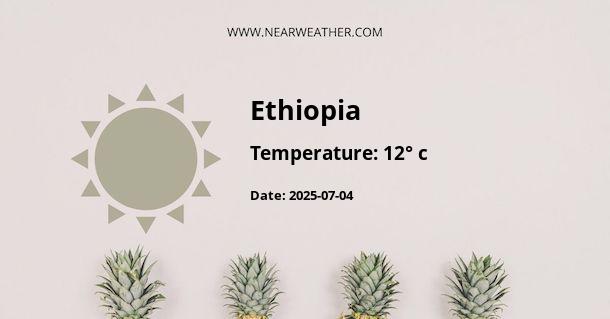Climate and Weather in Ethiopia
Ethiopia, officially known as the Federal Democratic Republic of Ethiopia, is a landlocked country located in the Horn of Africa. It is known for its diverse landscapes, rich history, and unique culture. The climate in Ethiopia varies significantly based on altitude and geographical location, resulting in distinct weather patterns throughout the country. Here, we will explore the climate and weather conditions in Ethiopia throughout the year.
Geographical Factors
Ethiopia's diverse topography plays a crucial role in shaping its climate. The country is characterized by highlands, plateaus, and lowlands, which influence temperature, rainfall, and humidity levels. The eastern part of Ethiopia is dominated by the Great Rift Valley, while the central and western regions are marked by the Ethiopian Highlands. The elevation of these highlands contributes to the variation in climate across different regions.
Seasons
Ethiopia experiences two main seasons: the dry season and the rainy season.
Dry Season: The dry season in Ethiopia typically occurs from October to May. During this period, the weather is generally dry, sunny, and warm. However, temperatures can vary significantly depending on the altitude. In the lowlands, temperatures can reach high levels, often exceeding 30°C (86°F), while in the highlands, temperatures are generally cooler, ranging from 15°C to 25°C (59°F to 77°F).
Rainy Season: The rainy season in Ethiopia usually extends from June to September, with the peak rainfall occurring in July and August. The onset and duration of the rainy season can vary across different regions of the country. The highlands and central parts of Ethiopia receive the most rainfall, while the lowlands and eastern regions experience relatively less precipitation. The average annual rainfall in Ethiopia ranges from 500mm to 2000mm (19.7 inches to 78.7 inches).
Regional Variations
Ethiopia's diverse climate and topography result in significant regional variations in weather conditions. Here are some key regions and their respective climate characteristics:
1. Ethiopian Highlands
The Ethiopian Highlands, including the Simien and Bale Mountains, are characterized by a cool and temperate climate due to their higher altitudes. The temperatures in these regions can drop to as low as 0°C (32°F) during the coldest months. The highlands receive significant rainfall, especially during the rainy season, making them fertile and suitable for agriculture.
2. Great Rift Valley
The Great Rift Valley, located in eastern Ethiopia, experiences a hot and dry climate. Temperatures in this region can soar above 40°C (104°F) during the hottest months. The Great Rift Valley is known for its stunning landscapes and unique geological features.
3. Danakil Depression
The Danakil Depression, located in the northeastern part of Ethiopia, is one of the hottest places on Earth. It has an extremely arid climate, with temperatures reaching well above 50°C (122°F) in some areas. This region is known for its volcanic activity and unique geological formations.
4. Somali Region
The Somali Region, located in the southeastern part of Ethiopia, experiences a semi-arid climate. The region receives relatively less rainfall compared to other parts of the country. Temperatures can be high, especially during the dry season, with averages ranging from 25°C to 40°C (77°F to 104°F).
Climate Change
Ethiopia, like many other countries, is also witnessing the effects of climate change. Over the past few decades, the country has experienced changes in rainfall patterns, increased frequency of droughts, and rising temperatures. These changes pose significant challenges to agriculture, food security, and water resources in the country.
Conclusion
Ethiopia's climate and weather conditions are diverse and influenced by geographical factors such as altitude and topography. The country experiences distinct dry and rainy seasons, with regional variations in temperature and rainfall. Understanding Ethiopia's climate is crucial for various sectors, including agriculture, tourism, and infrastructure development. As climate change continues to impact the world, it becomes increasingly important to monitor and adapt to these changes to ensure the sustainability and well-being of Ethiopia and its people.
A - Ethiopia's Latitude is 8.000000 & Longitude is 38.000000.
A - Weather in Ethiopia is 18° today.
A - Climate Conditions in Ethiopia shows light rain today.
A - Humidity in Ethiopia is 62% today.
A - Wind speed in Ethiopia is 8.96 km/h, flowing at 344° wind direction. today.
